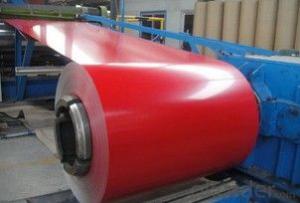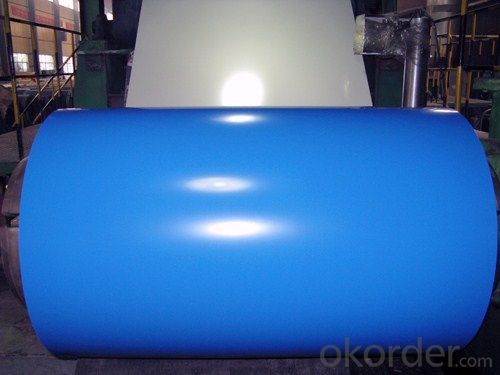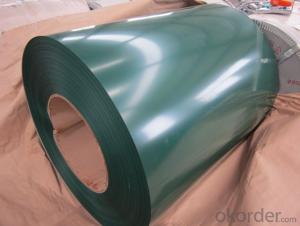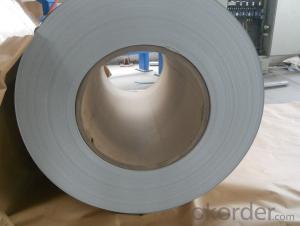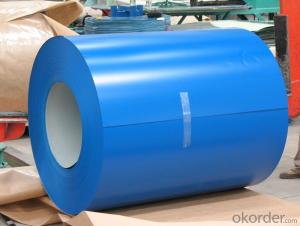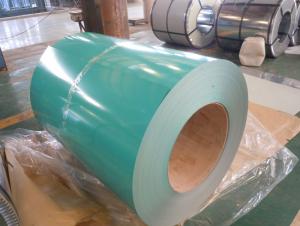PRE-PAINTED STEEL COILS
- Loading Port:
- China Main Port
- Payment Terms:
- TT OR LC
- Min Order Qty:
- -
- Supply Capability:
- -
OKorder Service Pledge
OKorder Financial Service
You Might Also Like
Painting steel isthe product based on the metal sheet, of which surface is finally installed ofthe plastic film(PVC, PE) IN addition to being firstly covered with the coatingand printed ink in. The coated layer of painting steel plate consists of chemicaland filming layer, primer coated layer, pattern printed layer and surfacecoated layer. The top and back coating shall generally be the weatherproofpaint, as well can be the application of the paint with special capabilitiessuch as stain-resistant, self cleaning capability, high thermal resistance,antistatic capability, sterilizing capability, finger-print prevention and etc.
With GI(aluzinc) asbase metal, after pretreatement(degrease and chemical treatment)and liquid dopewith several layers of color, then after firing and cooling, finally the platesteel is called pre-painted galvanized (aluzinc)steel. Pre-painted galvanized steelis good capable of decoration, molding, corrosion resistance. It generallydisplays superior workability, durability and weather resistance.
Availablespecification:
PAINTING STEEL | |
BASE MATERIAL | HDGI, ALUZINC,CR |
GRADE | SGCC, DX51D,ASTMA653,EN10142,S350GD |
THICKNESS | 0.17-1.0mm |
WIDTH | 600-1250mm |
ZINC COATING | 60-200g/㎡ |
PAINT | PE,PVDF,SMP,HDP |
COILED | 508mm |
COIL WEIGHT | 3-6mt |
We can supply customers' with different specifications of the highest quality and lowest price.
Sincerely welcome to contact us for the future details if any item interest you ,and we will make every effort to assure that your requirements will be satisfied ,and we hope to establish long-term business relations with you on the basis of the equality and mutual benefit.
We are waiting for your email.
- Q: There's this huge community of steelians (steelites?) in my town. Has anybody heard of this Dr. Steel?
- steel okorder thank you for posing this question. all hail dr.steel.
- Q: I would like to know if steel is basically a very dense crystal, or if it is a different atomic structure
- Steel okorder /
- Q: What are the challenges in coil slitting?
- Coil slitting, a method used to divide large metal coils into narrower strips of desired widths, has its advantages in terms of efficiency and flexibility. However, it also comes with several challenges. One of the primary obstacles in coil slitting is the need to ensure consistent strip width accuracy. To achieve this, it is crucial to maintain uniform width measurements throughout the process. Any deviation in strip width can have downstream effects on the production line, impacting the quality and functionality of the final product. Overcoming this challenge requires the use of precise slitting equipment and careful monitoring of process parameters. Another challenge lies in managing the quality of the strip edges. The edges of the slit strips play a critical role, particularly in applications where they must be free from imperfections like burrs. Attaining clean and smooth edges necessitates proper blade selection, positioning, and maintenance. Any defects or irregularities on the strip edges can affect subsequent processes such as bending, welding, or coating. Additionally, the type of material being slit can pose challenges. Certain metals, such as high-strength steels or alloys, may be more difficult to cut due to their hardness or brittleness. Slitting these materials can result in blade wear and premature failure, leading to increased downtime and maintenance costs. Moreover, the presence of contaminants or surface defects on the coil can also impact the slitting process, requiring additional cleaning or preparation steps. Handling and processing large coils present another significant challenge. Coils can be cumbersome and heavy, necessitating proper equipment and procedures to ensure safe handling. Furthermore, the slitting process generates a significant amount of scrap material, which needs to be efficiently managed and disposed of. Proper storage, transportation, and recycling of the scrap are essential to minimize waste and maintain a clean and organized working environment. In conclusion, coil slitting offers benefits in terms of customization and productivity. However, it also poses challenges in maintaining strip width accuracy, managing edge quality, dealing with difficult materials, and handling large coils and scrap. Overcoming these challenges requires expertise, precision equipment, and careful process control to ensure the desired quality and efficiency in coil slitting operations.
- Q: What is galvanized steel coil?
- Galvanized steel coil refers to a steel sheet that has been coated with a protective layer of zinc to prevent corrosion and increase its durability. This process, known as galvanization, involves immersing the steel coil in a bath of molten zinc, creating a bond that forms a protective barrier against moisture, chemicals, and other elements that can cause rusting. The result is a versatile and long-lasting material commonly used in construction, automotive, and manufacturing industries.
- Q: The difference between aluminized color steel roll and ordinary color steel roll
- Substrate selection: AZ150 (aluminum zinc content 150g/m2); G345A high strength galvanized steel sheet (55% aluminum, 43% zinc and 1.6% silicon) corrosion resistance data: 5%NaCL 35 DEG C, 1000Hrs, Field good, Scribe, No, Blister, 2mm belowQ.U.V: 2000hrs, MAX.2 color, light to keep the rate above 90%, the above data show that aluminum zinc coated board (AZ150, G345A, PVDF) is very suitable for the extreme environment of buildings or other facilities, highly corrosion resistance and weather resistance, and the major steel plate can ensure the service life of 20 years. In addition, high strength steel has been widely used abroad, and it has good economic performance, and it is also the domestic development trend.
- Q: How are steel coils inspected for straightness?
- Steel coils are inspected for straightness through a variety of methods to ensure they meet the required quality standards. One common method is visual inspection, where trained inspectors visually examine the coil for any visible defects or deformations that may indicate a lack of straightness. They carefully observe the coil's edges, surface, and overall shape to identify any irregularities. Another method used is measuring the coil's straightness using precision instruments. This involves taking measurements at various points along the coil's length and comparing them against specified tolerances. Techniques such as laser measurements or straightness gauges are employed to accurately assess the deviation from the desired straightness. Furthermore, some coils undergo non-destructive testing, such as magnetic particle inspection or ultrasonic testing, to identify any internal defects or stresses that could affect the straightness. These tests can reveal hidden flaws that may not be evident through visual inspection alone. In addition, some manufacturers may employ automated inspection systems that utilize advanced technologies like computer vision or artificial intelligence. These systems can quickly scan the coil's surface and analyze it for any deviations from straightness, providing precise measurements and ensuring consistent quality. Overall, the inspection of steel coils for straightness involves a combination of visual inspection, precise measurements, non-destructive testing, and advanced technologies. These methods aim to identify any deviations from the required straightness, ensuring that only coils meeting the specified standards are used in various applications.
- Q: What are the different types of steel coil transport methods?
- There are several different types of steel coil transport methods, including flatbed trucks, coil racks, coil cradles, and coil trailers. Each method offers unique advantages and is used based on factors such as coil size, weight, and transportation requirements.
- Q: Where can a find a steel scrubber. Its great to clean cooking vessels. Would be great if someone gives me an idea. I did not find it at CVS, but was in a hurry, will try again tomorrow.
- I posted this earlier to a similar question... Really burnt on gunk in the bottom like milk or blackened food can easily be cleaned out of stainless steel pots and pans by sprinkling baking soda in the bottom, covering with vinegar, let simmer with a little water for 5 min. Let cool, scrub out with a vinyl scrubby. or I use a lot of stainless steel for cooking and over the years have found a very inexpensive solution to cleaning them especially the ones with burnt food stuck at the bottom. I use Used fabric softner sheets (sheets that i have already used in the dryer for my clothes) and have them soak in water in the dirty pan overnight. Next morning i use the same sheet as scrubber to clean the pan and all the burnt food comes off easily leaving a new look to the pan. Try it this works.
- Q: I personally don't believe the story of 8 guys who flew small planes can navigate passenger jets into buildings hundreds of miles away with that precision. It just doesn't make sense.I am wondering what the story surrounding the molten steel was, how could molten steel have been produced when fuel from the planes wasn't hot enough (it melts at 2850 degrees)?
- that's just it: there wasn't very much molten steel for the very reason you point out. Jet fuel burns at 800° to 1500°F. This is not hot enough to melt structural steel. However, engineers say that for the World Trade Center towers to collapse, their steel frames didn't need to melt, they just had to lose some of their structural strength. Steel will lose about half its strength at 1,200 degrees F. The steel will also become distorted when heat is not a uniform temperature. after the collapse, a LOT of folks took a look at the remains. the result was the conclusion that the fire caused the central core of the building to weaken. When the floors collapsed one on top of the other, the weight was too much for the weaked core to bear, causing the result we are all familiar with. hope this helps
- Q: What are the different methods of coil handling and storage?
- Various industries commonly employ several different methods for coil handling and storage to ensure safety, efficiency, and preservation. Some of these methods include: 1. Coil cradles: Popular for handling and storing coils, coil cradles feature a U-shaped structure that provides stability and support. The cradle is positioned beneath the coil and can be easily maneuvered using forklifts or overhead cranes. 2. Coil cars: Used for transporting coils within a facility or between locations, coil cars are equipped with specialized clamps or arms to securely hold the coil during transit. Manual or automatic operation is determined by coil size and weight. 3. Coil racks: Specifically designed storage systems for organized coil storage, coil racks are typically constructed from steel and feature multiple levels or compartments to accommodate various coil sizes and types. Forklifts or overhead cranes are used to access coil racks. 4. Coil turnstiles: In processing lines where continuous coil feeding into machines is required, coil turnstiles are employed. These rotating devices enable easy loading and unloading of coils by rotating them to the desired position, facilitating handling and processing. 5. Coil pallets: Specially designed pallets made of steel or wood, coil pallets are utilized for both storage and transportation of coils. Their unique configuration allows for convenient loading and unloading using forklifts or pallet jacks. Coil pallets are often utilized for long-distance transportation or warehouse storage. 6. Coil storage racks: Large storage systems designed for bulk coil storage, coil storage racks are typically made of steel and feature multiple levels or compartments to accommodate a significant number of coils. Forklifts or overhead cranes are utilized for accessing coil storage racks. These examples represent only a selection of the numerous coil handling and storage methods commonly employed across various industries. The specific method chosen depends on factors such as coil size and weight, available space, and industry-specific requirements.
Send your message to us
PRE-PAINTED STEEL COILS
- Loading Port:
- China Main Port
- Payment Terms:
- TT OR LC
- Min Order Qty:
- -
- Supply Capability:
- -
OKorder Service Pledge
OKorder Financial Service
Similar products
Hot products
Hot Searches
Related keywords
